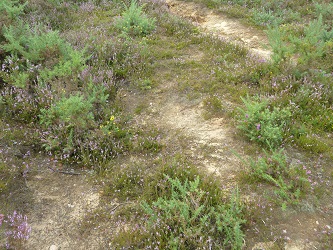Current ISIS code: F111
Previous assemblage name: Composed of F111, F112 open short sward, and F116 dune, heath & calcareous early successional habitats, but amalgamated by 2007.
Linked assemblage: Can often be found in the company of F112 open short sward.
Description of habitat typically supporting the assemblage: This SAT is supported by multivariate analysis of samples of several insect groups taken in 2006 and 2007. It occurs repeatedly at the extreme end of the main axis of variation in ordinations of samples taken from the ground and field layer of terrestrial sites. It contains species that are associated with hot, dry soil conditions normally found in bare ground in early successional habitats. It is therefore dependent on natural or anthropogenic disturbance and is likely to be responsive to climate change. Even though the SAT is well expressed through the “No. spp.” score, the “% of national species pool” score is generally very low relative to other SATs and this should be borne in mind when selecting features of interest.

The assemblage type is dominant in lowland habitats where disturbance removes vegetation to create areas of bare or sparsely vegetated ground. Suitable sources of disturbance include landslips, wind and salt blast on sea cliffs, sand accretion on sand dunes and small-scale poaching by grazing animals.

The juxtaposition of disturbed areas of bare ground with other structural types of vegetation is often important to insects with complex life cycles that require different microhabitats at different stages of development. This juxtaposition is associated with small-scale dynamic processes driven by cyclical disturbance patterns. Many species are efficient at dispersing and colonising newly formed habitats, but landscapes with some degree of continuity of habitat are more likely to hold assemblages of the highest conservation value. Habitat continuity is often associated with nutrient-deficient soils or exposure regimes that deflect ecological succession. Semi-natural biotopes supporting important examples of this assemblage type include sea cliffs, sand dunes, heathland and chalk downland. Arable land on nutrient-poor and freely-draining soils can also support interesting examples as can recently disused quarries and post-industrial and urban demolition sites. However, at these latter sites, the original source of disturbance is not cyclical, so the assemblage cannot sustain itself without the imposition of a management regime that introduces a suitable disturbance pattern.
Sampling & assessing the assemblage
Standard sampling protocols apply, though sweeping time should be increased.
Target groups: aculeates, Coleoptera, larger Diptera, day-flying Lepidoptera, Heteroptera.
Fieldwork methods: Ground-searching, spot-sweeping.
Alternative methods: Suction sampling.
Season: Summer months.
Suction sampling in very sandy areas can be tricky and can end up sand-blasting the catch. Spot sweeping is important as the fauna is often honey-potted on such sites towards flowering plant stands, although sweeping around obvious nest aggregations can be productive.
Discrimination of conservation quality: good
Default target: 19 species
